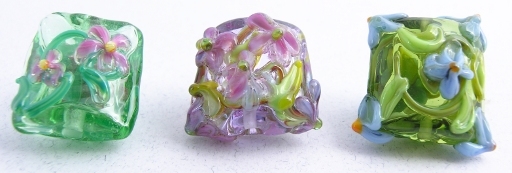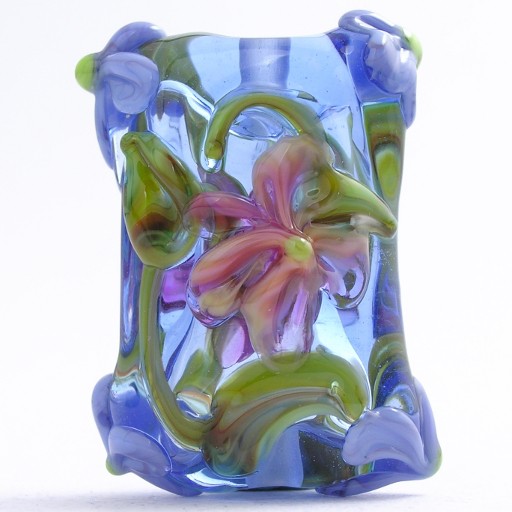I've mentioned before that one way to develop new ideas is work off old ones. Oh, and your mistakes:) I use this technique all the time. The series of beads in the picture below illustrates the approach very well: on the left, a fairly typical floral made with a pillow bead press. In the middle, I was trying to make a similar bead, but my stringer control was badly off (to be honest it wasn't so great in the bead on the left, either, but it was at least acceptable) and the glass trailing to make the flower petals foamed and bubbled and just generally looked awful (it's not too bad-looking at this resolution, but if you bring up the full-size image you can easily see what I mean.) The bead looks even worse "in person". —It badly puffed on one side, and at that point there wasn't really any point in trying to save it (though I like the zing all the mustard yellow glass gives the leaf cane—contrasts with the purple nicesly).

from left to right, 3 pillow pressed beads, showing evolution of flower placement. Beads, hollow pressed effetre (or check), soda lime glass, 3/32 mandrels, perhaps the last 3–6 months.
So, since the bead couldn't be salvaged, I started screwing around, plopping flowers anywhere—including the one that barely shows, on the upper left. It was lopsided and poorly positioned, but still looked kinda cool, so then I followed up with the two on the bottom corners. Ah! An idea worth saving. The third bead in the series shows the concept more deftly executed. Naturally, since the intermediate forms are often kind of awkwardly ugly, you typically don't see them, just this abrupt transition between forms 1 and 3.
I include this bead mostly because I like the photography: I stood the bead up, so much of the light illuminating it is transmitted, rather than reflected, which increases the drama to the piece. The trick is to balance the transmitted and reflected light, so the front surface still reads well, (rather than becoming a silhouette.) I shot this bead in a light cube, with an extra sheet of diffusing plastic coupled with a white sheet held in front of the bead to bounce more light on the front surface. (A mirror would've bounced more, but been too harsh. Glass especially needs very diffuse light to prevent hot spots. As it is, there's a tiny one on the green flower center.) I particularly liked the way the pink of the petals blended with the cobalt base to make a sort of purple halo around the [opaque] parts of the flower.
photos 29, 30 apr, file 30 apr09.
Unless otherwise noted, text, image and objects depicted therein copyright 1996--present sylvus tarn.
Sylvus Tarn